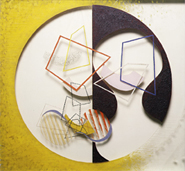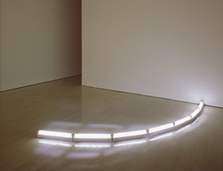  |
In the early twentieth century a number of modernist artists chose to address the articulation and perception of real, non-illusionary space through the application of advanced technology and materials in their work. Viewing space as a reality of sensory experience that operated according to rational laws and could best be grasped through the manipulation of light and motion, László Moholy-Nagy sought to delineate space through the layering of transparent planes in plastic reliefs such Space Modulator (1939–45). Similarly, Naum Gabo's delicate webbed constructions, such as Linear Construction, No. 1 (ca. 1945–46), make use of fine nylon monofilaments to capture and reflect light, all but disintegrating traditional mass and volume. A concern with the perception of space also characterizes the work of a number of American artists in the 1960s whose work falls under the rubric of Minimalism, but with particular attention to the physical and temporal relationship of the viewer to the object in the real space of the museum or gallery. Set directly on the floor without the intermediary of a pedestal, the industrially fabricated, geometric sculptures of artists like Carl Andre and Dan Flavin occupy the same space as the viewer and interact with their architectural surroundings. Rather than merely representing or containing space internally, they incorporate and direct our awareness to the surrounding site. Extending such phenomenological concerns with the temporal and bodily perception of space, Alyson Shotz's The Shape of Space (2004) (see overview page for image) foregrounds the viewer's perception and engages its environment on a massive scale. Installed on the ground floor of the Guggenheim rotunda, Shotz's piece presents a shimmering wall of over 18,000 ovals of hand-cut plastic which capture, refract, and magnify the surrounding architecture, as well as the bodies of the viewers themselves. |
ABOVE, LEFT TO RIGHT: |
|
|